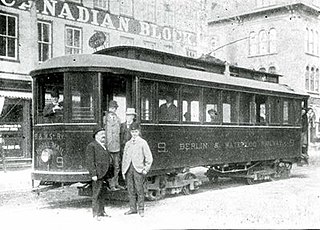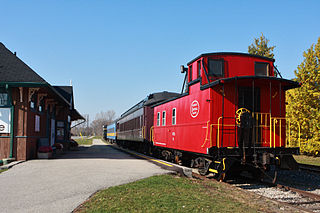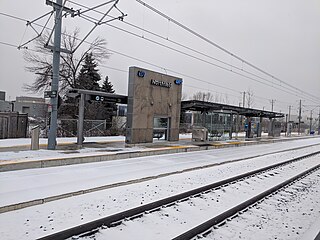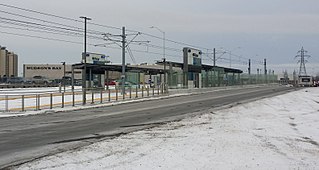
Grand River Transit (GRT) is the public transport operator for the Regional Municipality of Waterloo, Ontario, Canada. It operates daily bus services in the region, primarily in the cities of Kitchener, Waterloo, and Cambridge, alongside the ION rapid transit light rail system which began service on June 21, 2019.
Galt is a community in Cambridge, Ontario, Canada, in the Regional Municipality of Waterloo, Ontario on the Grand River. Prior to 1973, it was an independent city, incorporated in 1915, but amalgamation with the village of Hespeler, the town of Preston and the village of Blair formed the new municipality of Cambridge. Being the largest constituent community in the city, it is commonly seen as the downtown core of Cambridge. The first mayor of Cambridge was Claudette Millar.

Kitchener station is a railway station located in Kitchener, Ontario, Canada, slightly to the northeast of downtown Kitchener, at 126 Weber Street West, near the corner of Victoria Street. It is a heritage building containing a waiting room and ticket counter built beside a set of tracks also used as a freight yard. A separate building to the east of the passenger area, originally built in 1925 as a freight building, now serves as the headquarters for the Goderich–Exeter Railway.

The Grand River Railway was an interurban electric railway in what is now the Regional Municipality of Waterloo, in Southwestern Ontario, Canada.

Gare du Palais is a train and bus station in Quebec City, Quebec, Canada. Its name comes from its proximity to the former location of the Palace of the Intendant of New France. It is served by Via Rail, Canada's national passenger railway, and by the private coach company Orléans Express.

The Kitchener and Waterloo Street Railway was a street railway in Berlin and Waterloo in Waterloo County, Ontario, Canada. Horsecar service began in 1888 under the original Berlin and Waterloo Street Railway name and continued until the system was electrified in 1895, when the existing horsecars were converted for electric service. This proved ineffective, and the company suffered from under-investment. In 1896, a local consortium bought out the company and purchased a new fleet of purpose-built electric trams. The system was municipalized in 1907 and was run by the Town of Berlin/Kitchener until the end of service. The railway was renamed in 1919 to reflect the name change of the City of Kitchener, which had occurred in 1916. In 1927, it was reorganized under the Kitchener Public Utilities Commission, which continued operations until 1946, when streetcar service was discontinued and replaced with trolleybus service.

The Iron Horse Trail is a multi-use urban rail trail which connects the cities of Waterloo and Kitchener, Ontario, Canada. It runs from Erb Street West in the north near Uptown Waterloo, to Ottawa Street South in Kitchener to the south. It covers a distance of 5.5 kilometres (3.4 mi). The trail was opened on 5 October 1997 on abandoned Canadian Pacific Railway right of way sections, including portions of the right-of-way of the now-defunct Grand River Railway. The two cities combined resources to purchase the property. It is a part of the Trans Canada Trail.

Ion, stylized as ION, is an integrated public transportation network in the Regional Municipality of Waterloo in Ontario, Canada. It is operated by Keolis and is part of the Grand River Transit (GRT) system, partially replacing GRT's Route 200 iXpress bus service. The section of the bus route serving Cambridge has been renamed "Ion Bus", and renumbered as 302. The first phase commenced operations on June 21, 2019, between the north end of Waterloo and the south end of Kitchener. A future extension of light rail to the downtown Galt area of Cambridge is planned but construction may not begin on that line until 2028. In 2023, Ion LRT had an annual ridership of 4.3 million, and a daily ridership of 11,780.

The Waterloo Central Railway (WCR) is a non-profit heritage railway owned and operated by the Southern Ontario Locomotive Restoration Society (SOLRS). In May 2007, SOLRS received joint approval from the Region of Waterloo and the City of Waterloo to run trains from Waterloo to St. Jacobs and potentially as far north as Elmira. On a typical operating day, the train runs three times a day on Tuesdays, Thursdays and Saturdays. In 2015, the railway lost regular running rights south of Northfield Drive to make way for the Ion light rail project. All Market Train service now runs between St. Jacobs Farmers' Market, the Village of St. Jacobs, and Elmira, Ontario.

The Charles Street Transit Terminal is a former bus terminal in Kitchener, Ontario, Canada. It is the former downtown hub for local Grand River Transit (GRT) bus services for Kitchener and Waterloo, although the terminal now sits vacant and mostly abandoned.

The Ainslie St. Transit Terminal is a bus station and terminal in Cambridge, Ontario, Canada. It is located in the core of Galt, a former city which is now a community within Cambridge.

The Union Station Rail Corridor (USRC) is a corridor of railway tracks that exist through and adjacent to Union Station in downtown Toronto. It is 6.4 kilometres long, approximately stretching from Bathurst Street in the west to the Don River in the east, making it the largest rail passenger facility in Canada.

Central Station is a light rail station in Kitchener, Ontario, Canada, which is planned to be expanded into an intermodal transit terminal. As of 2021, it consists of an Ion light rail stop and Grand River Transit bus stops. The site is planned to also include a train station served by Via Rail and GO Transit, and an intercity bus terminal.

Kitchener Market is a stop on the Ion rapid transit system in the Region of Waterloo in Ontario, Canada. It is located in the Cedar Hill neighbourhood at the intersection of Charles and Cedar streets, about 100 metres (330 ft) south of its namesake, the Kitchener Farmer's Market. The station initially had a working name of Cedar, and it opened in 2019.

Northfield is a stop on the Region of Waterloo's Ion rapid transit system. It is located on Northfield Drive in Waterloo, between Parkside Drive and the Conestoga Parkway, at the existing railway corridor. It opened on June 21, 2019.

University of Waterloo Station is a bus terminal and light rail station located at the University of Waterloo in Waterloo, Ontario, Canada. The site initially opened as a light rain station on Grand River Transit's ION light rail line in 2019, and the bus terminal for GRT buses was subsequently opened in 2022. The bus terminal is shared with GO Transit, which uses the easternmost eastbound platforms as its University of Waterloo Terminal for its intercity bus service.

Willis Way is a stop on the Region of Waterloo's Ion rapid transit system. It is located on Caroline Street in Waterloo, at Willis Way. It opened in 2019.

Fairway is a light rail station and bus station in Kitchener, Ontario, Canada. It is a stop on the Region of Waterloo's Ion rapid transit system. The station is located just off Wilson Avenue between Fairway Road and Kingsway Drive, adjacent to the Fairview Park Mall. Fairway is the southern terminus of the Ion light rail line, with adapted bus rapid transit continuing on toward Cambridge. The station opened on June 21, 2019. At the same time as the light rail launch, the existing bus terminal was moved from its current location adjacent to the Hudson's Bay store, to a new park and ride lot at the corner of Fairway and Wilson, off of the mall property.

The Preston and Berlin Street Railway was an interurban electric street railway which served the 12.68 kilometres (7.88 mi) between what was then the towns of Preston and Berlin in Midwestern Ontario, Canada. The company was formed in 1894, but lay dormant until 1900, when construction finally began. The company began operation in 1904.

The Waterloo Junction Railway (WJR) is a short line railway in the Region of Waterloo, Ontario, Canada. It runs northward from the former Grand Trunk Railway (GTR) North Main Line in downtown Kitchener, through Waterloo and St. Jacobs before terminating in Elmira. It is currently owned by the City of Waterloo and operated by CN as the Waterloo Spur. The Waterloo Central Railway runs tourist trains on the line, and the Ion rapid transit runs on the route for a short distance.



















